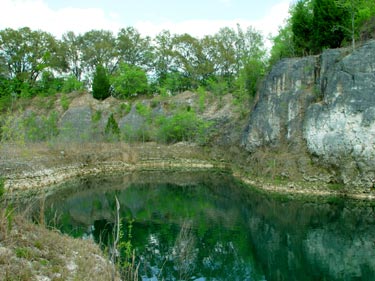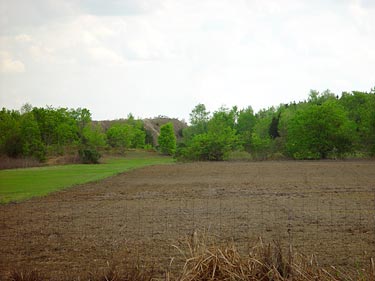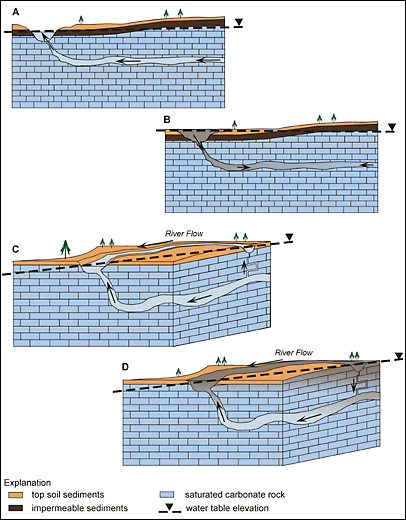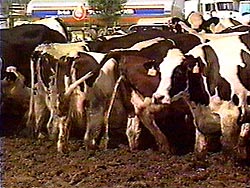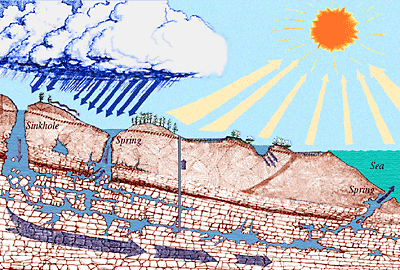Problems of Groundwater and Surface Water Management: Part 1
Problems of Groundwater & Surface Water Management: Part OneBY DR. TODD KINCAID
When we think about environmental quality, there exists a tendency to segregate the environment into distinct categories, namely air, water, and land. While each environmental category has its own specific challenges and is governed by sometimes-different physical laws, there also exists significant interaction between the realms. Most of us by now are familiar with these interactions even if the technical lingo with which they are often described is not as familiar. For instance, throughout the seventies and eighties we became increasingly alert to how air pollution in the form of SMOG can generate acid rain and degrade the quality of surface water bodies and forest health. In the same time period, we've seen dramatic examples of how poorly planned land development strategies can contribute to water quality declines as in the problems Florida continues to face along the mangrove coasts, erosional problems such as the loss of beach front, and, in some cases, a degradation of air quality via dust and other particulate matter. For many years now, the various problems confronting the protection and management of air, water, and land have been studied, debated, and attacked to varying degrees; however, the interactions between sub-environments has largely been overlooked by both the scientific and regulatory communities. Actually, "overlooked" is probably an unfair assessment; rather, a better characterization would be that both science and the legislatures have attacked the problems along a prudent path of "divide and conquer. "At this stage, unfortunately, it has become apparent to many people in both the scientific and regulatory camps that the "divide and conquer" strategy will not solve the problems to the extent that most Americans desire and expect. We have now reached a stage of technical understanding, capability, and need from which it is imperative that we embrace environmental interactions and attempt to address problems from a more holistic approach. Indeed, this type of approach is steadily dominating the discourse on environmental issues, examples of which include most discourses using the terms "sustainability," "systems," and "stewardship." Once we accept that the interactions rather than the specifics of a particular sub-environment are the keys to developing adequate protection and management strategies, we're confronted with numerous types of interactions that are constantly occurring both within each of the three broader environmental categories, air, water, and land, and between them. For instance, an entire field of study has grown over the past ten years specifically devoted to the investigation of mineral surface interactions. Others focus on interactions between air and water contaminants and microbiological communities; air quality and weather patterns; surface water quality and quantity and the health of coastal ecosystems; just to name a few that dominate the environmental section of the newspaper. My purpose, with this article, is to draw attention to the interactions between groundwater and surface water that have a more direct bearing on the quality of groundwater that, in turn, affects the springs, caves and rivers, in which we dive. This article is Part One of a two-part discussion of the groundwater/surface water issue. This part will address the laws that provide the incentive for protection and remediation efforts. Part Two will highlight some of the scientific principles that will determine how protection and remediation strategies should be designed.From a regulatory perspective, groundwater and surface water have been and continue to be managed from different perspectives and under the authority of different laws. Surface water is regulated under the Clean Water Act (CWA), which is a 1977 amendment to the federal Water Pollution Control Act of 1972. Groundwater is regulated under three laws; the Comprehensive Environmental Response, Compensation, and Liability Act (CERCLA) of 1980, commonly known as the "Superfund Act," the 1984 amendment to the Resource Conservation and Recovery Act (RCRA), and the 1986 and 1996 amendments to the federal Safe Drinking Water Act (SDWA) which created the Well Head Protection Area (WHPA) and Source Water Assessment and Protection (SWAP) programs. Both surface water and groundwater are also regulated under various pieces of state-level legislation designed to meet or exceed standards set forth in the CWA, CERCLA, and RCRA. Surface WaterThe CWA was enacted by Congress to regulate the discharge of pollutants to the surface waters of the United States and charged the Environmental Protection Agency (EPA) with the responsibility of setting and maintaining technology-based water-quality standards for all contaminants in surface waters. Enforcing the standards is largely left to state governments that have typically developed independent regulatory agencies to oversee the task, e.g. the Florida Department of Environmental Protection (FLDEP). The CWA has three specific goals:
By 2003, the EPA is expected to implement a new program nationwide that will shift the focus of water quality management from one of largely point-source control to one that also embraces non-point sources. The new program will usher in a shift in regulatory philosophy away from effluent limitations to water quality standards. Interestingly, the shift in regulatory philosophy is being accompanied by a shift in regulatory camps. The camp driven by the moral imperative is adopting the water quality standard approach because it is largely based on the measured health of a water body and will include mandates for both point- and non-point-source pollution, while the economically driven camp has adopted the effluent limitation stance largely because the task of regulating non-point source pollution is both practically and economically daunting.
The Water Quality Standards (WQS) approach is designed to:
Establishing and enforcing WQSs will be achieved through the calculation of Total Maximum Daily Loads (TMDLs) for each pollutant and each water body. The TMDL is a calculation of the amount of a pollutant that a body of water can receive and remain in compliance with the stated WQS or the sum of all allowable loads of a single contaminant from all contributing point and non-point sources. Though most states have been working with TMDLs for some time, until now, they were not used as the primary method of establishing regulatory limits. The state of Florida will embark on an aggressive program to establish TMDLs for all surface water bodies in the state beginning in fiscal year 2002. It should be evident that what is evolving is much more of a "systems" approach to water quality management, and that the new program will very likely be drastically more expensive to implement at least in the short-run than the traditional effluent limitation approach. Prior to the late seventies and early eighties, most people regarded groundwater as an insulated resource. It was generally believed that the rock and soil separating water in the ground from the land surface would filter out unwanted contaminants and that the only real issue was developing strategies to more effectively remove groundwater for public water supply. Those beliefs were substantially rocked on August 7, 1978, when President Jimmy Carter declared part of a small neighborhood near Niagara Falls, New York a federal emergency area as a result of a growing recognition of health problems associated with contaminated soil and groundwater. The "Love Canal" site, as it came to be internationally recognized, was the first federal emergency declared as a result of a man-made problem and ushered in a new period of awareness about groundwater and the vulnerability of groundwater to contamination. Both CERCLA and the 1984 amendment to RCRA were established largely in recognition of this vulnerability. After its initiation, CERCLA grew from a $1.6 billion program in 1980 to a $15 billion program in 1994. By 1993, the EPA estimated that the number of hazardous waste sites in the U.S. was more than 330,000, where the average cost of cleanup for each Superfund site was $27 million as of 1994. It was quickly realized that the problem of protecting and remediating groundwater resources is far more complex and costly than the same efforts for surface water bodies. To complicate the issue, prior to 1980 there were very few scientists that had begun to delve into the technologies that have been necessary to confront the problem.
Karst caves, including both dry caves and the underwater caves in which we dive, and unfractured dense bedrock, make up the two extreme end-members of geologic environments which control the rate and pattern of groundwater flow. At the one end of the spectrum, karst caves create preferential pathways for the extremely rapid conveyance of water and contaminants from a point of entry into the cave system throughout an aquifer and then to one or more discharge points. From a regulatory perspective, these environments are very problematic because the caves are often hard to find, especially when one remembers that a cave the size of a thumb is capable of carrying water and thus contaminants at velocities on the order of 10s of meters per day or more. Protecting a karst groundwater resource then becomes a job of finding the flow paths and protecting every source of entry to the flow system from possible contamination. Remediating already contaminated sites becomes a job of finding the flow paths and capturing through-flowing contaminated water as well as potentially removing contaminant sources that seep into one or more cave passages.
Dense bedrock aquifers and aquifers comprised of other types of low-permeability materials are characterized by very slow and more disperse groundwater flow patterns. Remediation efforts at these types of sites can be problematic because, if permitted to permeate deeply into the formation, contaminants can be very hard to remove due to the slow flow rates. The physical properties of the contaminants themselves present another level of complexity that plagues regulatory efforts. The three main categories of contaminants include:
The state of Florida pursues aquifer protection primarily through the SWAP program and is one of the more forward thinking states in the country with respect to aquifer protection and management. Unfortunately, this is probably, at least in part, due to the marked decline in the water quality at most of FloridaÕs springs over the past 10 to 20 years. While the state has developed and implemented innovative protection strategies, Florida also remains one of the fastest growing states in the country, with the result that balancing the demands of wise land management with the demands of a growing population has been difficult. For this reason, land and resource managers at many levels of the State government have turned to land acquisition as what they believe to be the best solution to resource protection. Many of the state parks in Florida have expanded their boundaries in the past 10 years, a trend that we will probably see continue into the next decade. Nonetheless, land acquisition alone will not be able to protect groundwater from contamination because it will be impossible to purchase enough of the aquifer vulnerability areas to make an impact. So the bad news is that surface and groundwater resources continue to be threatened by contamination and that the strategies to adequately protect those resources are going to be costly. The good news is that our legislative efforts to effect the required protection efforts are beginning to view the problems from a more holistic perspective and that surface water strategies (WQS & TMDL) and groundwater strategies (SWAP) are becoming more and more complimentary. Surface water regulators struggling to establish TMDLs for rivers and streams are now forced to address groundwater discharges, while groundwater regulators struggling to delineate aquifer vulnerability zones are looking more closely at surface water reservoirs as possible sources of contamination. What we should expect to see evolve is a far more holistic approach to water management, one where a renewed emphasis is placed on understanding the interactions between groundwater and surface water systems, interactions that were previously considered two separate and unrelated issues from a regulatory perspective.
Though the technical issues of managing groundwater and surface water are complex and much remains to be learned, as this holistic approach evolves, the most challenging problem will very likely prove to be political rather than scientific. In order to make these new programs work, we are going to be faced with some tough decisions, decisions that will affect property rights, land access, personal responsibility, and our wallets. After the aquifer vulnerability zones are delineated, the next step in the regulatory process will be to revamp zoning ordinances that will undoubtedly affect how property owners are allowed to develop and utilize their land. Should a property owner be forced to lose equity because of changes in acceptable land-use practices that benefit us all? Zoning ordinances and the aquifer and surface water regulation strategies will likely be contested on a case-by-case basis as these issues begin to take center stage. Who will be held responsible for cleaning up already contaminated sites and for ensuring that new contamination does not take place? This will be a particularly challenging question as focus is directed to non-point sources of contamination like agricultural runoff and suburban storm water discharges polluted with a multitude of household chemicals. Implementing treatment systems for such discharges will come at considerable cost, costs that will most likely need to come from taxes passed by our legislators and that will require the support of the citizenry. As a scientist, I have traditionally viewed problems from a purely technical perspective. Here an objective has been defined--protect water resources from contamination. Over the past 20 to 30 years our understanding of the problems and our technical capabilities have evolved to the point where we can now achieve that objective. The solutions are fairly straightforward: delineate vulnerable areas; don't allow development and/or land use practices in those areas that could contribute to contamination; clean up or seal off already contaminated sites so that the problem won't spread. However, as a citizen, I realize that understanding how to achieve that goal and actually achieving that goal are two separate issues. Ultimately, I believe that our success will largely be a test of both our resolve as a people to remain focused on the problem and to pay the costs associated with achieving the goal, and of our willingness to accept personal responsibility for the lifestyle changes that will be required to fairly distribute those costs. REFERENCESU.S. EPA, 2000a. National Water Quality Inventory: 1998 Report to Congress. EPA 841-R-00-001, Environmental Protection Agency Office of Water (4503F), Washington, D.C. U.S. EPA, 2000b.ÊWater Quality Conditions in the United States:ÊA Profile from the 1998 National Water Quality Inventory Report to Congress. EPA-841-F-00-006, U.S. Environmental Protection Agency Office of Water (4503F) Washington, D.C. Rodgers, W.H., Jr., 1994. Environmental Law (Second Edition). West Publishing, pp 259. Mallman, W.L., and Mack W.N. 1961. Biological cont-amination of groundwater. Pp. 35-43 in Groundwater Contamination:ÊProceedings of the 1961 Symposium, Cincinnati, Ohio, April 5-7, 1961.Ê PB-214895. Springfield, Va.: National Technical Information Service.
|


